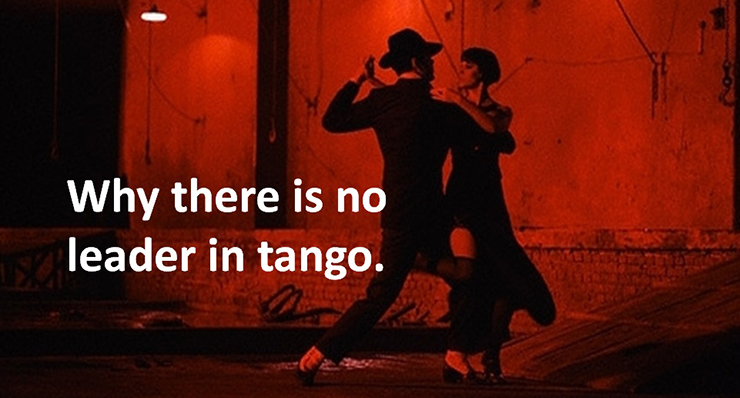Why there is no leader in tango

Tango is a dance of leaders and followers. Yet if leadership has anything to do with bossiness, there is no place for it in tango. It is foremost a dance of subtlety and invitation.
This way – as in many ways – tango also has a lot to say about life in general, about leadership in all kinds of organizations. Let’s talk about men and women as leaders and followers in tango, as this is the ‘usual case.’ At first sight, the man leads the woman. What actually happens however – at least when the dancing is nice – is that the man invites the woman to a certain movement or step. He does this as subtly as possible, yet also as clearly as possible. The woman accepts the invitation… or not. It’s her choice. Generally, she accepts because she likes to. Doing so, she lets the dance unfold itself. It is then the woman who starts the execution of the step. The man… follows her into the step.
So who leads whom?
Both man and woman follow the music, to a certain degree. The music too is no more nor less than an invitation. They also follow the ‘milonga’ or dancing hall, mainly the other dancers. It is the man’s responsibility to create a nice and safe environment for the couple. His attention is oriented more externally and towards the sequences of steps. The woman’s responsibility is more exclusively oriented internally, towards where the dancing actually happens: the embrace, the responsiveness in the epicenter of the dance. So who has the most responsibility? No one. Or you may say: it completely depends upon your viewpoint.
In the end, there is no leader in tango, even while there is very clearly a leader in tango. This is also what tango can teach us about leadership in general: there is no leader. There is subtlety and clear invitation. At least when life is danced nicely.
A good leader is humble, though not self-effacing at all. A good follower is supportive, though not self-effacing at all. Both need to be very deeply attentive to the other, not at the first place to oneself. In organizational leadership thinking, this is well developed in the concept of servant leadership. Indeed the leader should serve the follower. And vice versa, not primarily because of an old-fashioned hierarchy, but simply because dancing this way is nice. The dance of life. Tango.


